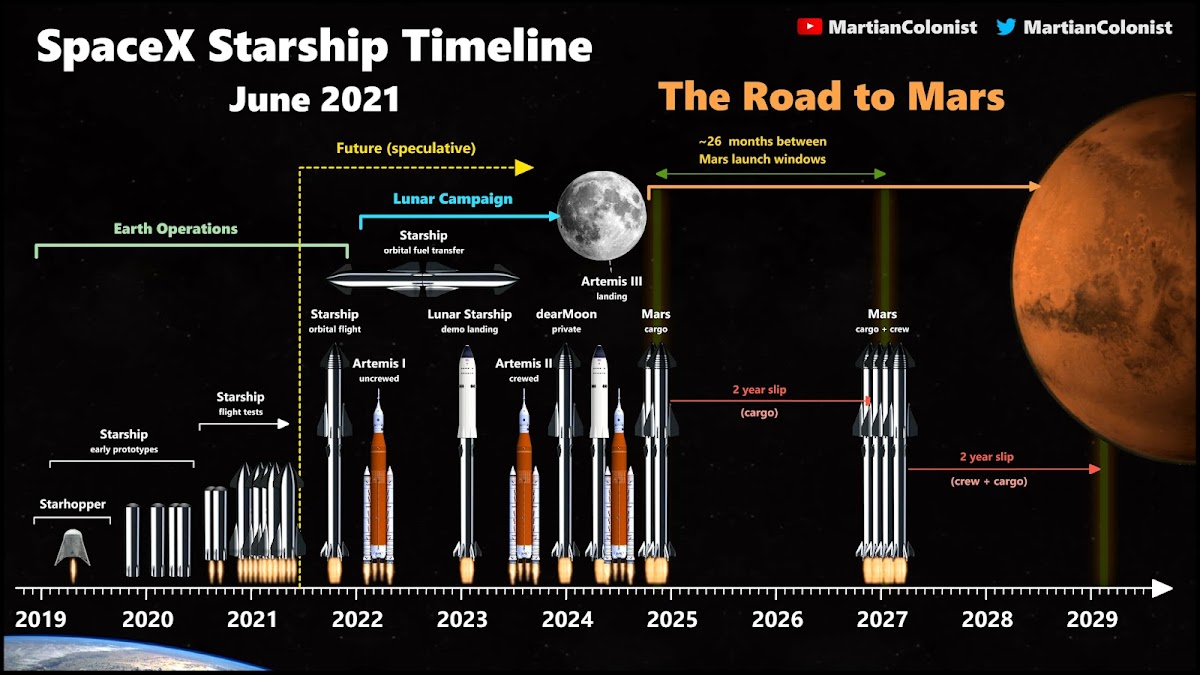SpaceX chose 7 probable landing locations for Starship on Mars. Will SpaceX get humans to Mars by 2026?

Saturday, November 27, 2021 | Chimniii Desk
Key Highlights
- Elon Musk remains sure that his rocket business SpaceX will land humans on Mars in 2026, when he plans to establish a human community.
- Despite the fact that the Starship rocket has been tried and tested, Autry noted that the booster, life support system, reentry system, and capability to refuel on Mars have not been tested – and some components have not even been created.
- If all of the launches, new technology, system tests, and landings happen as planned and Musk maintains sufficient cashflow, DeBruin believes SpaceX might reach Mars by 2026.
- However, there are concerns about the bulk required to land on Mars, DeBruin added.
Advertisement
7 probable landing locations for Starship on Mars
In September 2019, SpaceX stated that it had chosen five potential Starship landing locations on Mars. The candidate locations were in Southern Arcadia Planitia east of Erebus Montes and in Phlegra Montes.
Since then, SpaceX has held multiple workshops with members of the Mars science community to analyse and restrict the list of potential landing sites on Mars. Each site must meet the following criteria:
1. near proximity to major water/ice deposits, a needed resource for in situ propellant generation and a consumable for habitation;
2. elevation below -2 km (relative to the MOLA geoid) that supports the delivery of heavy payloads, with -3 km desired;3. Solar energy and thermal management require a latitude of 40°, and proximity to the equator is advantageous;4. multiple distinct landing places within a few kilometres of one another to support the numerous missions required to build an outpost;5. Slopes should be 5° over a 10 m length scale, and the probability of encountering a rock more than 0.5 m high (1 m diameter) should be 5%;6. the landing site must be radar reflective to enable distance measurements to the surface, and it must be load bearing to support the spacecraft upon touchdown.
Recently, an abstract with the study's conclusions was published (the study's findings will be presented in two weeks at the 52nd Lunar and Planetary Science Conference), identifying four prime and three secondary potential Starship landing sites in Phlegra Montes, Erebus Montes, and Southern Arcadia Planitia for further study:
1. PM-1 has the lowest latitude and elevation of the Phlegra Montes sites, a strong association with LDAs (local ice deposits expressed as lobate debris aprons), well-developed polygons (one of the indicators of ice-related morphologies), and the highest SWIM (Subsurface Water Ice Mapping) score for ice geomorphic indicators;2. The site AP-1 (Arcadia Planitia) looks to be one of the safest, with a modest combined SWIM score for ice.3. According to radar returns (from the Arcadia Planitia locations) and geomorphology, AP-9 has the thickest ice. Although it gets the highest combined SWIM score for ice, it appears rocky and rugged.4. The strongest radar return for shallow ice and the highest aggregate SWIM score among the Erebus Montes locations are found at EM-16, which shows a clear link with an LDA with surrounding brain terrain.5. The site AP-8 (Arcadia Planitia) appears to be one of the safest, with the best neutron and combined SWIM scores for ice.6. EM-15 (Erebus Montes) contains well-developed polygons, surrounding cerebral terrain, and appears smooth; it is connected with a conspicuous but less extensive LDA.7. PM-7 is the safest of the Phlegra locations since it is next to lineated valley fill (due to glacial flow).
We highlighted selected ★ prime and ★ secondary sites on the map:


Advertisement
Will SpaceX get humans to Mars by 2026?

Elon Musk remains sure that his rocket business SpaceX will land humans on Mars in 2026, when he plans to establish a human community.
Musk stated in a recent wide-ranging interview with the audio-only Clubhouse app that it will take "five and a half years" for a crewed voyage on SpaceX's Starship rocket to land on Mars.
"What matters is that we construct a self-sustaining culture on Mars," he remarked.
Advertisement

Despite the fact that the Starship rocket has been tried and tested, Autry noted that the booster, life support system, reentry system, and capability to refuel on Mars have not been tested – and some components have not even been created. This means that it will almost certainly take longer to develop the technology necessary to establish a society on Mars beyond Starship.
"There is a great deal of work going on there that is being obscured by the dramatic landing system tests," Autry explained.
Six times the mass we currently possess is required, he stated. "We require new landing technologies that will enable us to land a greater mass on the surface of Mars for humans to dwell, operate, and then return home."
Biological concerns may also be involved. According to DeBruin, the longest period of continuous human spaceflight is little under a year, but the Mars mission will take much longer. "We will continue to see deterioration of the human body," he said.
SpaceX's mission to Mars is "something NASA should have done years ago," according to Nutt. Given that the space agency's vision has dimmed in the aftermath of the big moon walk and is hampered by politics, he believes SpaceX may fill the hole.
Follow us on: Google News
Advertisement